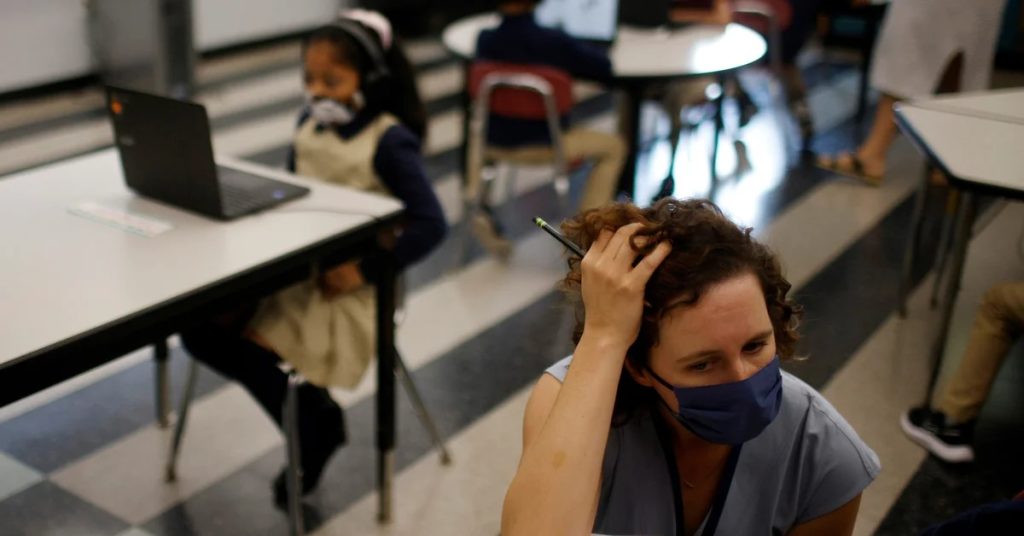Scientists create carbon dioxide-based model to measure COVID-19 risks in offices and classrooms

:quality(85)/cloudfront-us-east-1.images.arcpublishing.com/infobae/CXTUFYP7ZEZA4AVWBEGVPKMVLM.jpg 420w)
As more workers return to offices and regular classes continue, The problems associated with creating potential controls that reduce virus traffic are maximized. In the framework of developing strategies in this regard, a working group composed of specialists from Department of Civil and Environmental Engineering, Imperial College London It was published in a new article published in the magazine Indoor and built environment The model that was developed for Expect the risk of COVID-19 infection in the air in these places, as occupancy varies throughout the day.
The model, developed by researchers from Imperial College London, and the University of Cambridge along with the University of Leeds, It uses controlled CO2 (carbon dioxide) and occupancy data to predict how many people might be infected by an asymptomatic but contagious fellow.
We release carbon dioxide when we exhale, so the Higher levels of carbon dioxide in a room are associated with increased occupancy and decreased ventilation. Therefore, when it is possible to take the dimensions of the concentration of that substance It can provide an important red flag for building managers to identify areas of inadequate ventilation.
then changes can be made, for example, To improve air circulation or change worker attendance patterns to reduce occupancy. The form shows that Cutting office occupancy in half can reduce air transport risks by four times.
The importance of good ventilation
:quality(85)/cloudfront-us-east-1.images.arcpublishing.com/infobae/P2MVOAECHVCBRATAMBHILS4G64.jpg 420w)
Lead author of the study, Henry Burridge, FromDepartment of Civil and Environmental Engineering at Imperial, Note that “In common spaces such as offices and classrooms, exposure to infectious substances in the air builds up over time, During which room occupancy may vary. Using carbon dioxide levels as a substitute for exhalation, Our new model can assess changing exposure risks as people come and go.”
Our work confirms The importance of good ventilation in workplaces and schools. The form shows that By managing ventilation and occupancy levels in common spaces, we can manage the risks of airborne infection with a virus such as SARS-CoV-2, that causes COVID-19 ″, The specialist indicated.
While applications of the infection model so far have shown that Most workers in open, well-ventilated offices are unlikely to infect each other through airborne particles, and the risk increases if the space is poorly ventilated or if workers engage in activities that require more talk. For example, the model predicts that Each infected person can infect two or four other people in the call center but with adequate ventilation. very The risk is likely to increase if the affected individual is a ‘super diffuser’.
:quality(85)/cloudfront-us-east-1.images.arcpublishing.com/infobae/QBPTQWE6D5FMDKQYEVFRVV5XSY.jpg 420w)
The study was jointly funded with PROTECT COVID-19 Leading National Study and the UK Research and Innovation (UKRI). studying Protect On Transport and the Environment is a UK-wide research program that improves understanding of how SARS-CoV-2 is transmitted from person to person and how it varies across settings and settings. the teacher Andrew Curran, The chief scientific advisor to the Executive Director of Health and Safety and chair of the PROTECT study added: “This important investigation It states that while the airborne route of transmission can significantly contribute to the risk of infection with COVID-19 in places such as offices and schools, steps can be taken to reduce this risk and help facilitate safe return. “
“insurance Breathing is enough essential element, and proper use of tools such as CO2 Monitoring It can give building managers a better understanding of their ventilation systems and how they perform each activity performed in the space. However, keep going koran-, The air route is just one of three known routes of transmission of the COVID-19 virus. very The risks of surface and person-to-person transmission over short distances should be assessed. They must Implement relevant measures to control all exposure pathways for all activities in which the hazard has been identified. For most companies, the COVID-19 control strategy will include a common set of measures identified through risk assessment; There is no magic formula.”
the teacher Charlotte Dean Director UKRI for COVID-19 Response and Executive Vice President of Engineering and Physical Sciences Research Council, Referred to in this regard: “The main challenge throughout the pandemic has been Understand how this new virus is transmitted and put in place measures that can be implemented to slow the spread of infection.”
This study highlights that Research and innovation supported by UKRI and the National Basic Studies Program continues to advance our understanding of the virus and help us advance knowledge This will be key to global recovery after the pandemic.” religion.
Read on:

“Future teen idol. Hardcore twitter trailblazer. Infuriatingly humble travel evangelist.”




:quality(85)/cloudfront-us-east-1.images.arcpublishing.com/infobae/BNGH73UCKQAZSQPCODUWO2BE5Y.jpg)





